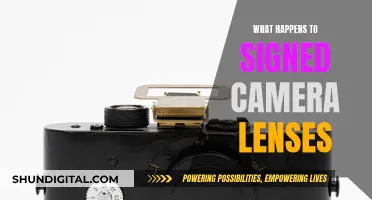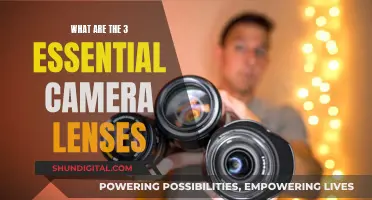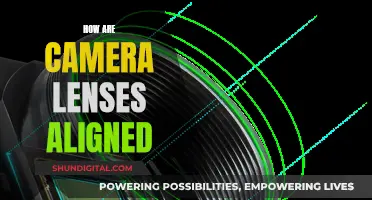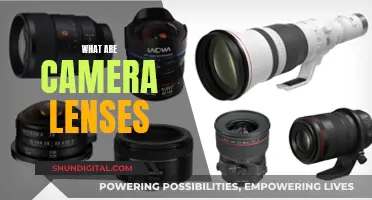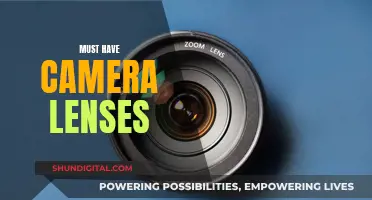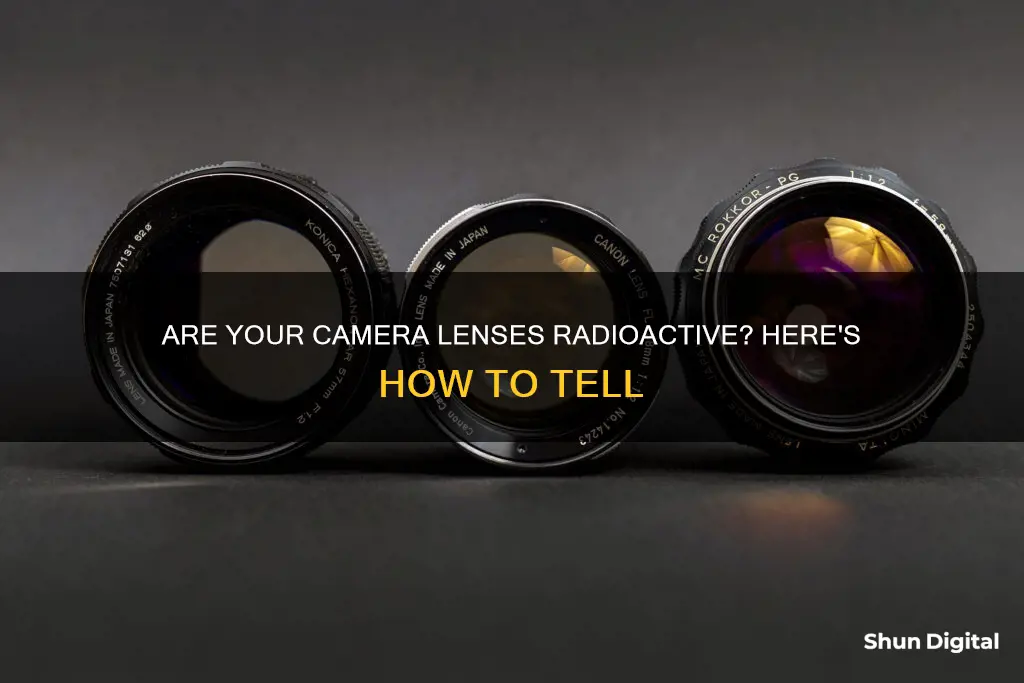
Many lenses produced between the 1940s and the 1970s emit a measurable amount of radioactivity. This is due to the use of thorium, a weakly radioactive metallic chemical element, in the glass elements of the lenses. The thorium was used to improve image quality, but it has the side effect of causing the lenses to develop a yellowish tint over time.
The most reliable way to determine whether a lens is radioactive is by measuring it with a Geiger counter. However, for those without access to one, a visual inspection can be used as a backup. A yellow tint to the lens elements is a good indicator that a lens is radioactive, although ageing and the composition of the glass can also cause discolouration.
| Characteristics | Values |
|---|---|
| Reason for radioactivity | Thorium and lanthanum |
| Use of thorium | Improve image quality |
| Yellow tint | Yes |
| Health risk | No |
What You'll Learn
- Thorium and lanthanum are the main elements that make vintage lenses radioactive
- Radioactive lenses can be identified by a yellowish tint on the glass
- Radioactive lenses are not harmful to health
- Radioactive lenses can be de-yellowed by exposing them to UV light
- Radioactive lenses can damage digital cameras by forming hot pixels on the sensor

Thorium and lanthanum are the main elements that make vintage lenses radioactive
Thorium dioxide is added to the glass to increase the refractive index while maintaining low dispersion. These properties are especially beneficial for making optical glass. A high refractive index means light travels slower within the glass, and therefore, changes its direction more easily. Lenses can have a lower profile, require less material, and thus be lighter.
Lanthanum is weakly radioactive because only 0.089% of it is lanthanum-138, a radioactive isotope, and the remaining 99.9% is non-radioactive lanthanum-139. The radioactivity from lanthanum is so small that it is not detectable without sensitive lab equipment.
The addition of thorium to the glass mixture creates the high refractive indexes necessary in sophisticated lens designs. The selection of premium quantities of glass from large glass pots, stringent spectrophotometric tests after stress and strain checks, provide the valuable raw glass for ultimate use in lens elements.
Camera Lenses: Weatherproof or Not?
You may want to see also

Radioactive lenses can be identified by a yellowish tint on the glass
The most reliable way to determine whether a lens is radioactive is by measuring it with a Geiger counter.
Disassembling and Cleaning Camera Lenses: A Step-by-Step Guide
You may want to see also

Radioactive lenses are not harmful to health
It is understandable to be concerned about the health risks associated with radioactive lenses, but it is important to know that these lenses are not harmful to health when used properly. Radioactive lenses contain small amounts of radioactive substances, such as thorium and lanthanum, which are used to enhance the optical properties of the glass. While these substances are radioactive, the level of radioactivity is low and does not pose a significant risk to human health.
Health Risks
The main health risk associated with radioactive lenses is the potential for increased radiation exposure, particularly to the eye. However, this risk is minimal as the radiation emitted by these lenses is typically very low and can be blocked by simple eyeglasses. In addition, the radioactivity of these lenses decreases over time due to the long half-life of thorium.
Safe Handling
To ensure safe handling of radioactive lenses, it is important to avoid breaking or grinding the lens elements, as this can create radioactive dust that could be inhaled or ingested. It is also recommended to wash hands after handling these lenses and to store them in a safe place away from humans, especially children.
Comparison to Other Sources of Radiation
It is worth noting that we are exposed to radiation from various sources every day, such as walking outside in the sun, staying indoors, eating bananas, and flying on an aeroplane. The radiation emitted by radioactive lenses is comparable to these sources and does not pose a significant additional risk.
While it is important to treat radioactive lenses with care, there is no need to be overly concerned about their health effects. With proper handling and storage, these lenses can be safely used and enjoyed without posing a risk to human health.
Polarized Camera Lenses: Worth the Investment?
You may want to see also

Radioactive lenses can be de-yellowed by exposing them to UV light
Radioactive lenses, which were produced from the 1940s through the 1970s, can be identified by their yellowing lens elements. This yellowing is caused by the radiation-induced formation of colour centres in the glass matrix. The yellowing can be reversed by exposing the lenses to UV light.
Methods of exposing lenses to UV light
There are several ways to expose lenses to UV light, including:
- Sunlight: This method is free but has some drawbacks, such as the potential for UV-filtering windows to hamper the annealing process, and the heat from the sun may cause issues with the lens grease.
- Ikea Jansjö LED lamp: This cheap lamp can be positioned close to the lens and has the benefit of not emitting heat.
- UV bulbs: These can be purchased for under $15 and emit high-frequency light, but they are harder to set up than the Ikea lamp.
Results of exposing lenses to UV light
Users have reported success in de-yellowing lenses using all three of these methods. One user reported that it took up to 7 days of exposure to sunlight to see a positive effect, while another user reported that 2.5 days of exposure to a UV bulb was sufficient to achieve nice results.
GoPro Hero 6: Are Older Lenses Compatible?
You may want to see also

Radioactive lenses can damage digital cameras by forming hot pixels on the sensor
Radioactive lenses contain thorium oxide, which increases the refractive index while maintaining low dispersion. These properties are especially beneficial for making optical glass. However, the addition of thorium oxide to the glass also makes it radioactive. The radiation from the thorium oxide in the lenses can damage digital camera sensors.
The radiation from the lenses is not strong enough to be a health risk. However, it is strong enough to damage digital camera sensors over time. The radiation can cause the formation of hot pixels on the sensor, which can affect the image quality.
To avoid damage to your digital camera sensor, it is recommended to store radioactive lenses separately from your camera and only use them occasionally. Additionally, when not in use, keep them in a shielded container, such as an aluminium case, to minimise radiation exposure.
The Impact of Constant Lens Usage on Camera Performance
You may want to see also
Frequently asked questions
The most reliable way to determine whether a lens is radioactive is by measuring it with a Geiger counter. However, if you don't have access to one, you can do a visual inspection. Radioactivity causes lens elements to turn yellow over time. However, ageing and the composition of the glass can also cause discolouration, so this method is not foolproof.
No, only some lenses produced between the 1940s and the 1970s are measurably radioactive.
The inclusion of thorium dioxide, the oxide of the radioactive element thorium, in the glass elements of the lenses.
Radioactive lenses are relatively safe. The radiation emitted by these lenses is minimal compared to the radiation we are exposed to from other sources, such as walking outside in the sun, eating bananas, and getting an x-ray at the doctor.
To avoid elevated radiation exposure, store radioactive lenses as far away from yourself as reasonably possible. An aluminium case is a good option as it is a good shielding material for alpha and beta particles.


